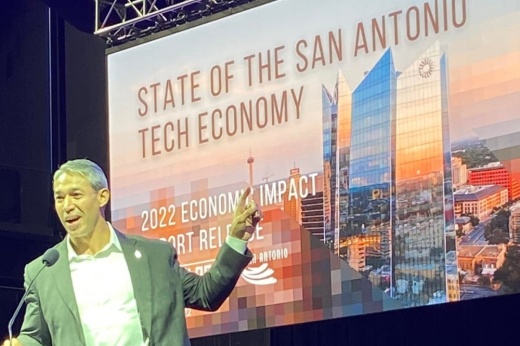A newly released study says the San Antonio area’s information technology industry keeps expanding with an annual economic effect of nearly $11 billion and increasing number of companies and employees in the private and public sectors.
The tech industry economic report was authored by renowned Trinity University professors Richard Butler and Mary Stefl and released by local advocacy organization Tech Bloc and economic development agency Port San Antonio.
Officials and industry members of Tech Bloc gathered June 29 at Tech Port Center and Arena to reveal key findings in the report, joined by Port San Antonio leaders, Mayor Ron Nirenberg and Bexar County Judge Nelson Wolff.
Tech Bloc CEO David Heard said this economic study—about three years in the works—is the first attempt in nearly a decade to measure the size and economic power of San Antonio’s tech industry.
“It’s the first effort to categorize and characterize the workforce and its impact on the local economy,” Heard said.
Heard said the COVID-19 pandemic has changed where and how various types of professionals, including tech workers, do their jobs.
But, despite the pandemic, the local information technology sector continues to grow, Heard said, adding that the study’s findings help to contribute clear, consistent data that the industry needs to guide policy and investments.
According to the report, the local IT industry’s economic effect has expanded by 27% since 2010, and it has more than tripled in size since 2000.
Another report highlight is that the number of local IT companies has grown from 1,095 in 2015 to 1,491 in 2020—a 36.16% increase. About 48,000 IT professionals work across the local private and public tech economic sectors.
Wolff and Nirenberg both lauded local tech industry leaders, saying that older, locally based companies such as Datapoint and Rackspace and groups such as Tech Bloc have spent years developing a local tech workforce as well as businesses and institutions capable of sustaining and strengthening a stable tech ecosystem citywide.
“We believe in entrepreneurship. We believe in the startup of business,” Wolff said, adding that San Antonio has become a destination for tech startups.
Wolff referenced the growth in San Antonio’s automotive manufacturing sector, with the presence of Toyota’s Tundra pickup assembly plant and surrounding service and parts suppliers and the arrival of manufacturer Navistar, both on the south side.
Wolff also expressed confidence in iconic DeLorean Motor Co. and its announced revival plans that call for a global headquarters at Port San Antonio.
Wolff said it is natural for people to compare San Antonio’s tech economy with its counterparts in places such as Austin.
“Keep watching us. We may not be a shooting star, but we’re a guiding star,” Wolff said.
Nirenberg said the increasing number of various tech ventures, the arrival of rideshare companies, and the recent opening of Tech Port Center and Arena at Port San Antonio are all just a few examples of the rise of San Antonio’s tech economy.
“This facility is emblematic of the projector that this city is on as a world-class center for innovation,” Nirenberg said of Tech Port Center and Arena, which provides numerous functions, including event, meeting and e-gaming space.
Nirenberg also cited San Antonio’s heavy military presence and how that and other federal agencies have contributed to the expansion of the local cybersecurity sector.
The report said about 16,400 IT professionals are employed by local defense, security and other federal entities, but because military and some other federal agencies typically keep their workforce information and other data sets classified, the 16,400 number is likely a conservative estimate, according to speakers such as Will Garrett, an executive at Port San Antonio.
Additionally, the University of Texas at San Antonio’s plan to open a School of Data Science—among other local higher education initiatives—is helping to develop a wealth of local tech-minded talent with San Antonio tech businesses aiming to keep that talent here in town, Nirenberg said.
“When you hear the data today, don’t think about where we are. Think about where we’re going to and what it takes to get there,” he added.
Tech Port Center and Arena also has a local office affiliated with Austin-based Capital Factory, a coworking space for startup ventures.
Joshua Baer, Capital Factory’s founder and CEO, said his organization works to treat all of Texas as a prime place for tech-centric startups. He praised San Antonio government and industry leaders for their efforts to promote and grow the local tech economy.
“It’s why San Antonio is such an essential part of this. Being the seventh largest city [in the United States] and with so much talent, it has so much to offer to the whole state and to what we’re doing,” Baer said.
Another critical finding in the report is that the average annual wage for local IT employees was $88,017, the highest average salary of all target industries in San Antonio. The average wage across San Antonio’s overall economy was $54,940 in 2020.
District 4 Council Member Adriana Rocha Garcia, who represents the Port San Antonio community, said such wages in the IT sector can help to increase socioeconomic opportunities for southwest side constituents and local residents citywide.
“Our residents deserve high wages and ample employment opportunities, and the IT industry is one of those fields worth investing in and talking about regarding its immense benefits,” Rocha Garcia said.
The report points to specific technology sectors of local workforce and economic strength, including cybersecurity; cloud computing; digital retail/commerce; financial technology services and compliance; and software-as-a-service, or software licensing and service delivery.
Butler said IT professionals represent 2% of San Antonio’s total workforce and, while that may seem like a minuscule number, it contains much potential to have a greater effect on the entire local economy.
“If we could grow those jobs, it would mean a tremendous amount of prosperity for San Antonio,” Butler said.
Heard said San Antonio also benefits from having a number of hubs of high concentration of IT professionals and employment opportunities citywide. He said Port San Antonio and its amount of federal, military, and local public and private enterprises and organizations has the city’s biggest number of IT workers.
According to Heard, the North US 281 corridor between Loop 410 and Loop 1604 has the city’s second highest concentration of IT professionals and companies. Other such hubs exist around Windcrest-based Rackspace, the South Texas Medical Center, Joint Base San Antonio-Fort Sam Houston, the main UTSA north side campus, downtown/midtown, Stone Oak and Texas A&M University-San Antonio, Heard said.
“This is very much a story of technological growth driven by convenience, urban accessibility and transportation,” Heard said.
Heard said the future of work is a little bit of an unknown given the number of professionals displaced by the pandemic, including those who are able to work from home.
Rackspace co-founder Dirk Elmendorf said the tech economic analysis speaks positively of San Antonio’s ongoing and future growth.
“We want more tech jobs; we want more tech businesses; we want more tech investments; and we all want to do our part to do that,” he said.





